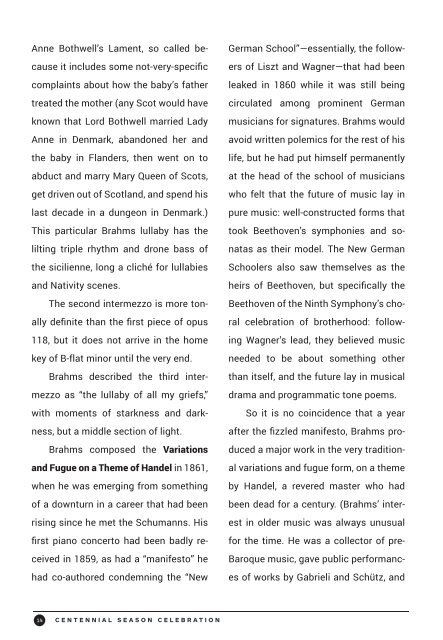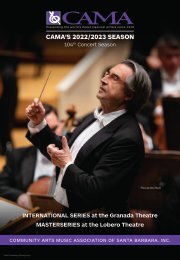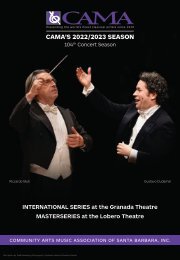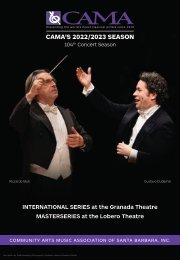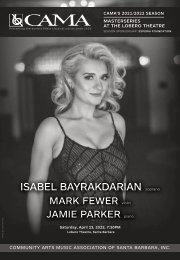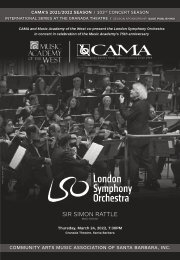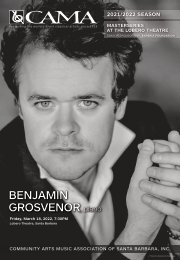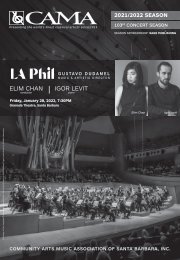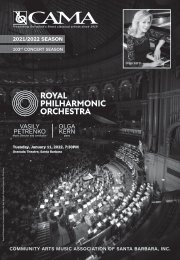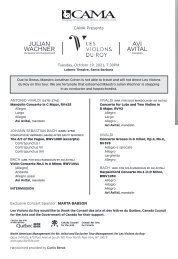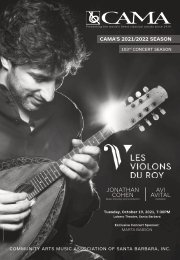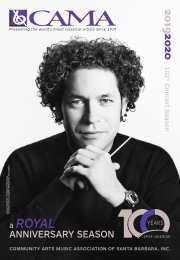Saturday, March 30, 2019—Garrick Ohlsson plays Brahms—CAMA's Masterseries at The Lobero Theatre, Santa Barbara
SATURDAY, MARCH 30, 2019, 8:00 PM CAMA's Masterseries at The Lobero Theatre Season Sponsorship: Esperia Foundation Garrick Ohlsson, piano ALL-BRAHMS PROGRAM: Piano Sonata No.2 in F-sharp minor, Op.2 6 Klavierstücke, Op.118 3 Intermezzi, Op.117 Variations and Fugue on a Theme by Handel, Op.24 Since his triumph at the 1970 Chopin Piano Competition, Garrick Ohlsson has established himself worldwide as one of the great American piano masters of the past 50 years, a musician of magisterial interpretive and technical prowess. Though long regarded as a leading exponent of the music of Frédéric Chopin, he commands an enormous repertoire, including more than 80 concertos ranging from Haydn and Mozart to works of the 21st Century. He returns to the Lobero for an all-Brahms recital on the heels of his virtuosic March 2017 performance for CAMA of the Brahms Piano Concerto No.2 with the St. Petersburg Philharmonic. #CAMASB #CAMAat100 #CAMACentennial
SATURDAY, MARCH 30, 2019, 8:00 PM
CAMA's Masterseries at The Lobero Theatre
Season Sponsorship: Esperia Foundation
Garrick Ohlsson, piano
ALL-BRAHMS PROGRAM:
Piano Sonata No.2 in F-sharp minor, Op.2
6 Klavierstücke, Op.118
3 Intermezzi, Op.117
Variations and Fugue on a Theme by Handel, Op.24
Since his triumph at the 1970 Chopin Piano Competition, Garrick Ohlsson has established himself worldwide as one of the great American piano masters of the past 50 years, a musician of magisterial interpretive and technical prowess. Though long regarded as a leading exponent of the music of Frédéric Chopin, he commands an enormous repertoire, including more than 80 concertos ranging from Haydn and Mozart to works of the 21st Century. He returns to the Lobero for an all-Brahms recital on the heels of his virtuosic
March 2017 performance for CAMA of the Brahms Piano Concerto No.2 with the St. Petersburg Philharmonic.
#CAMASB #CAMAat100 #CAMACentennial
Create successful ePaper yourself
Turn your PDF publications into a flip-book with our unique Google optimized e-Paper software.
Anne Bothwell’s Lament, so called because<br />
it includes some not-very-specific<br />
complaints about how the baby’s f<strong>at</strong>her<br />
tre<strong>at</strong>ed the mother (any Scot would have<br />
known th<strong>at</strong> Lord Bothwell married Lady<br />
Anne in Denmark, abandoned her and<br />
the baby in Flanders, then went on to<br />
abduct and marry Mary Queen of Scots,<br />
get driven out of Scotland, and spend his<br />
last decade in a dungeon in Denmark.)<br />
This particular Brahms lullaby has the<br />
lilting triple rhythm and drone bass of<br />
the sicilienne, long a cliché for lullabies<br />
and N<strong>at</strong>ivity scenes.<br />
<strong>The</strong> second intermezzo is more tonally<br />
definite than the first piece of opus<br />
118, but it does not arrive in the home<br />
key of B-fl<strong>at</strong> minor until the very end.<br />
Brahms described the third intermezzo<br />
as “the lullaby of all my griefs,”<br />
with moments of starkness and darkness,<br />
but a middle section of light.<br />
Brahms composed the Vari<strong>at</strong>ions<br />
and Fugue on a <strong>The</strong>me of Handel in 1861,<br />
when he was emerging from something<br />
of a downturn in a career th<strong>at</strong> had been<br />
rising since he met the Schumanns. His<br />
first piano concerto had been badly received<br />
in 1859, as had a “manifesto” he<br />
had co-authored condemning the “New<br />
German School”—essentially, the followers<br />
of Liszt and Wagner—th<strong>at</strong> had been<br />
leaked in 1860 while it was still being<br />
circul<strong>at</strong>ed among prominent German<br />
musicians for sign<strong>at</strong>ures. Brahms would<br />
avoid written polemics for the rest of his<br />
life, but he had put himself permanently<br />
<strong>at</strong> the head of the school of musicians<br />
who felt th<strong>at</strong> the future of music lay in<br />
pure music: well-constructed forms th<strong>at</strong><br />
took Beethoven’s symphonies and son<strong>at</strong>as<br />
as their model. <strong>The</strong> New German<br />
Schoolers also saw themselves as the<br />
heirs of Beethoven, but specifically the<br />
Beethoven of the Ninth Symphony’s choral<br />
celebr<strong>at</strong>ion of brotherhood: following<br />
Wagner’s lead, they believed music<br />
needed to be about something other<br />
than itself, and the future lay in musical<br />
drama and programm<strong>at</strong>ic tone poems.<br />
So it is no coincidence th<strong>at</strong> a year<br />
after the fizzled manifesto, Brahms produced<br />
a major work in the very traditional<br />
vari<strong>at</strong>ions and fugue form, on a theme<br />
by Handel, a revered master who had<br />
been dead for a century. (Brahms’ interest<br />
in older music was always unusual<br />
for the time. He was a collector of pre-<br />
Baroque music, gave public performances<br />
of works by Gabrieli and Schütz, and<br />
14 CENTENNIAL SEASON CELEBRATION


